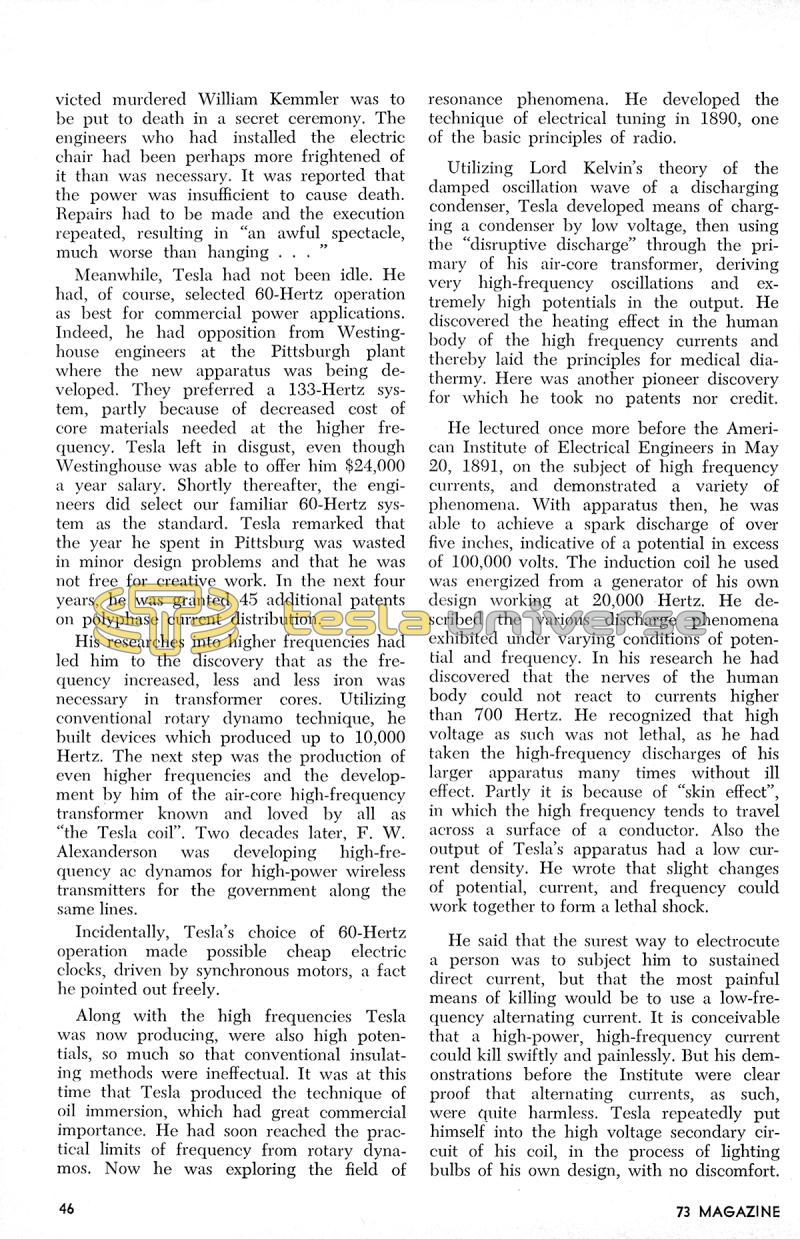
Nikola Tesla Articles
victed murdered William Kemmler was to be put to death in a secret ceremony. The engineers who had installed the electric chair had been perhaps more frightened of it than was necessary. It was reported that the power was insufficient to cause death. Repairs had to be made and the execution repeated, resulting in "an awful spectacle, much worse than hanging..."
Meanwhile, Tesla had not been idle. He had, of course, selected 60-Hertz operation as best for commercial power applications. Indeed, he had opposition from Westinghouse engineers at the Pittsburgh plant where the new apparatus was being developed. They preferred a 133-Hertz system, partly because of decreased cost of core materials needed at the higher frequency. Tesla left in disgust, even though Westinghouse was able to offer him $24,000 a year salary. Shortly thereafter, the engineers did select our familiar 60-Hertz system as the standard. Tesla remarked that the year he spent in Pittsburg was wasted in minor design problems and that he was not free for creative work. In the next four years, he was granted 45 additional patents on polyphase current distribution.
His researches into higher frequencies had led him to the discovery that as the frequency increased, less and less iron was necessary in transformer cores. Utilizing conventional rotary dynamo technique, he built devices which produced up to 10,000 Hertz. The next step was the production of even higher frequencies and the development by him of the air-core high-frequency transformer known and loved by all as "the Tesla coil". Two decades later, F. W. Alexanderson was developing high-frequency ac dynamos for high-power wireless transmitters for the government along the same lines.
Incidentally, Tesla's choice of 60-Hertz operation made possible cheap electric clocks, driven by synchronous motors, a fact he pointed out freely.
Along with the high frequencies Tesla was now producing, were also high potentials, so much so that conventional insulating methods were ineffectual. It was at this time that Tesla produced the technique of oil immersion, which had great commercial importance. He had soon reached the practical limits of frequency from rotary dynamos. Now he was exploring the field of resonance phenomena. He developed the technique of electrical tuning in 1890, one of the basic principles of radio.
Utilizing Lord Kelvin's theory of the damped oscillation wave of a discharging condenser, Tesla developed means of charging a condenser by low voltage, then using the "disruptive discharge" through the primary of his air-core transformer, deriving very high-frequency oscillations and extremely high potentials in the output. He discovered the heating effect in the human body of the high frequency currents and thereby laid the principles for medical diathermy. Here was another pioneer discovery for which he took no patents nor credit.
He lectured once more before the American Institute of Electrical Engineers in May 20, 1891, on the subject of high frequency currents, and demonstrated a variety of phenomena. With apparatus then, he was able to achieve a spark discharge of over five inches, indicative of a potential in excess of 100,000 volts. The induction coil he used was energized from a generator of his own design working at 20,000 Hertz. He described the various discharge phenomena exhibited under varying conditions of potential and frequency. In his research he had discovered that the nerves of the human body could not react to currents higher than 700 Hertz. He recognized that high voltage as such was not lethal, as he had taken the high-frequency discharges of his larger apparatus many times without ill effect. Partly it is because of "skin effect", in which the high frequency tends to travel across a surface of a conductor. Also the output of Tesla's apparatus had a low current density. He wrote that slight changes of potential, current, and frequency could work together to form a lethal shock.
He said that the surest way to electrocute a person was to subject him to sustained direct current, but that the most painful means of killing would be to use a low-frequency alternating current. It is conceivable that a high-power, high-frequency current could kill swiftly and painlessly. But his demonstrations before the Institute were clear proof that alternating currents, as such, were quite harmless. Tesla repeatedly put himself into the high voltage secondary circuit of his coil, in the process of lighting bulbs of his own design, with no discomfort.
